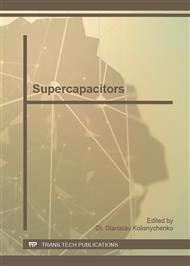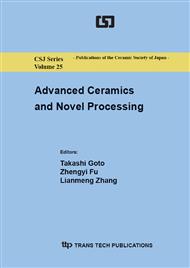[1]
G. Wang, L. Zhang, J. Zhang, A review of electrode materials for electrochemical supercapacitors, Chem. Soc. Rev. 41 (2012) 797–828.
DOI: 10.1039/c1cs15060j
Google Scholar
[2]
D. Pech, M. Brunet, H. Durou, P. Huang, V. Mochalin, Y. Gogotsi, P. Louis Taberna, P. Simon, Ultrahigh-power Micrometre-sized Supercapacitors based on Onion-like Carbon, Nature Nanotechnology 5 (2010) 651–654.
DOI: 10.1038/nnano.2010.162
Google Scholar
[3]
H. Pan, J. Li, Y.P. Feng, Carbon Nanotube for Supercapacitors, Nanoscale Res Lett. 5 (2010) 654–668.Carbon Nanotubes for Supercapacito car Carbon Nanotubes for Supercapacitor
DOI: 10.1007/s11671-009-9508-2
Google Scholar
[4]
Z. Wu, K. Parvez, X. Feng, K. Műllen, Graphene-based in-plane micro-supercapacitors with high power and energy densities, Nature Communications 4 (2013) 2487-2494.
DOI: 10.1038/ncomms3487
Google Scholar
[5]
Z. Yang, Y. Zhang, J. Kong, S. Wong, X. Li, J. Wang, Hollow Carbon Nanoparticles of Tunable Size and Wall Thickness by Hydrothermal Treatment of α‑Cyclodextrin Templated by F127 Block Copolymers, Chem. Mater. 25 (2013) 704−710.
DOI: 10.1021/cm303513y
Google Scholar
[6]
M. Almgren,W. Brown,S. Hvidt, Self-aggregation and Phase Behaviour of poly(ethylene glycol) - poly(propylene glycol) - poly(ethylene glycol) Block Copolymers in Aqueous Solution, Colloid Polym. Sci. 273 (1995) 2-15.
DOI: 10.1007/bf00655668
Google Scholar
[7]
M. L. Stewart, J. M. Stencel, CO2 Adsorption Techniques On High Surface Area Activated Carbons, 40511-8433 (1992) pp.1200-1205
Google Scholar
[8]
Y. H. Hu, E. Ruckenstein, Applicability of Dubinin–Astakhov equation to CO2 adsorption on Single-walled Carbon Nanotubes, Chemical Physics Letters 425 (2006) 306–310.
DOI: 10.1016/j.cplett.2006.05.059
Google Scholar
[9]
P. Simon,Y. Gogots, Materials for electrochemical capacitors, Nat. Mater. 7 (2008) 845.
Google Scholar
[10]
J. Chmiola, C. Largeot, P. L. Taberna, P. Simon, Y. Gogotsi, Monolithic Carbide-Derived Carbon Films for Micro-Supercapacitors, Science 328 (2010) 480-483.
DOI: 10.1126/science.1184126
Google Scholar
[11]
B. Daffos, P. L. Taberna, Y. Gogotsi , P. Simon, Recent Advances in Understanding the Capacitive Storage in Microporous Carbons, Fuel Cells 10 (2010) 819-824.
DOI: 10.1002/fuce.200900192
Google Scholar
[12]
H. Zhong, F. Xu, Z.H. Li, R.W. Fu, D.C. Wu , High-energy Supercapacitors based on Hierarchical Porous Carbon with an Ultrahigh Ion-accessible surface area in Ionic Liquid Electrolytes, J. Am. Chem. Soc. 130 (2008) 2730-2731.
DOI: 10.1039/c3nr00738c
Google Scholar
[13]
A.H. Vu, X.Y. Li, J. Phillips, A.J. Han, William H. Smyrl, P. Bühlmann, A. Stein, Three-Dimensionally Ordered Mesoporous (3DOm) Carbon Materials as Electrodes for Electrochemical Double-Layer Capacitors with Ionic Liquid Electrolytes, Chem. Mater. 25 (2013) 4137–4148.
DOI: 10.1021/cm400915p
Google Scholar
[14]
J. Li, X.P. Ni, Z.H. Zhou, K.W. Leong, Preparation and Characterization of Polypseudorotaxanes Based on Block-Selected Inclusion Complexation between Poly(propylene oxide)-Poly(ethylene oxide)-Poly(propylene oxide) Triblock Copolymers and r-Cyclodextrin, J. Am. Chem. Soc. 125 (2003) 1788-1795.
DOI: 10.1021/ja026623p
Google Scholar
[15]
Information on http://www.nippon-bel.co.jp/tech/seminar16_e.html
Google Scholar



